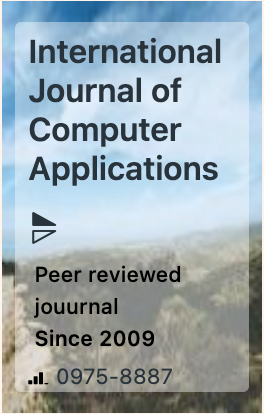The week's pick
Random Articles
Reseach Article
Divyawear- A Wearable Haptic Cueing System for the Visually Impaired Indian People
| International Journal of Computer Applications |
| Foundation of Computer Science (FCS), NY, USA |
| Volume 186 - Number 79 |
| Year of Publication: 2025 |
| Authors: Keyur D. Joshi, Nakshatra Maheshwari, Harsh Patel, Priyam A. Parikh |
 10.5120/ijca2025924707
10.5120/ijca2025924707
|
Keyur D. Joshi, Nakshatra Maheshwari, Harsh Patel, Priyam A. Parikh . Divyawear- A Wearable Haptic Cueing System for the Visually Impaired Indian People. International Journal of Computer Applications. 186, 79 ( Apr 2025), 54-67. DOI=10.5120/ijca2025924707
Abstract
This research investigates the conception and assessment of an innovative smart vest engineered to augment the mobility and autonomy of individuals with visual impairments. Recognizing the inherent limitations of conventional aids like canes and guide dogs, which often impede navigation in intricate environments, this study proposes a smart vest integrating advanced technologies, including 3-D cameras, LiDAR, and vibration motors. The system aims to furnish real-time environmental perception and directional guidance through haptic feedback, thereby mitigating the constraints associated with existing assistive devices. The paper details the design and development of two prototypes, DW-1 and DW-2, emphasizing the technical implementation of object detection algorithms (YOLOv8), distance measurement methodologies, and predefined vibration patterns for conveying environmental cues. Rigorous empirical evaluation across diverse navigational scenarios, encompassing linear trajectories, turns, and obstacle avoidance, demonstrated the efficacy of both prototypes in facilitating user navigation, with the DW-2 variant exhibiting superior performance attributed to its enhanced sensor suite. A comprehensive review of the extant literature contextualizes the advancements in assistive technologies and delineates the specific research lacunae addressed by this investigation. The findings of this study underscore the significant potential of intelligent wearable systems to enhance the quality of life for visually impaired individuals, thereby highlighting the imperative for continued scholarly inquiry and the refinement of such technological interventions.
References
- World report on vision. Geneva: World Health Organization; 2019. Licence: CC BY-NC-SA 3.0 IGO.
- International agency for prevention of blindness, 2024 Webpage: https://www.iapb.org/learn/vision-atlas/magnitude-and-projections/countries/india, Accessed: 28th March 2024
- National Program for Control of Blindness and Vision Impairment, India, 2019, the National Blindness and Visual Impairment Survey 2015-2019-A summary report, Source: https://www.npcbvi.mohfw.gov.in/
- World Health Organization, 2023, Blindness and Vision impairment Key facts, Webpage: https://www.who.int/news-room/fact-sheets/detail/blindness-and-visual-impairment, Accessed: 28th March 2024
- Report of the 2030 targets on effective coverage of eye care. Geneva: World Health Organization; 2022. License: CC BY-NC-SA 3.0 IGO
- Global report on assistive technology. Geneva: World Health Organization and the United Nations Children’s Fund (UNICEF), 2022. License: CC BY-NC-SA 3.0 IGO.
- World Health Organization, 2024, Assistive Technologies Key facts, Webpage: https://www.who.int/news-room/fact-sheets/detail/assistive-technology, Accessed: 28th March 2024
- Ertan, S., Lee, C., Willets, A., Tan, H., and Pentland, A. (1998). A wearable haptic navigation guidance system; An IEEE report, the media laboratory, Massachusetts Institute of Technology, USA.
- Tan, H. Z., Gray, R., Young, J.J., Traylor, R. (2003). A haptic back display for attentional and directional cueing. Haptics-e, 3(1).
- Nakamura, M., and Jones, L. (2003). An actuator for the tactile vest - a torso-based haptic Device; 11th IEEE symposium on haptic interfaces for virtual environment and teleoperator systems (HAPTICS’03), IEEE Computer Society, Washington, USA.
- Lindeman, R.W., Page, R., Yanagida, Y., and Sibert, J. L. (2004). Towards full-body haptic feedback: the design and deployment of a specialized vibrotactile feedback system; The ACM Symposium on Virtual Reality Software and Technology (VRST’04), Hongkong.
- Jones, L. A., Nakamura, M., and Lockyer, B. (2004). Development of a tactile vest; 12th IEEE symposium on haptic interfaces for virtual environment and teleoperator systems (HAPTICS’04), IEEE Computer Society, Chicago, USA.
- Bark, K., Wheeler, J., Lee, G., and Savalle, J. (2009). A wearable skin stretch device for haptic feedback; Third Joint Eurohaptics Conference And Symposium On Haptic Interfaces For Virtual Environment And Teleoperator Systems, Salt Lake City, USA.
- Vaucelle, C., Bonanni, L., and Ishii, H. (2009). Design of haptic interfaces for therapy; 27th International Conference on Human Factors in Computing Systems, CHI’09, Boston, USA.
- Tsetserukou, D., and Neviarouskaya, A. (2010). Innovative Real-Time Communication System with Rich Emotional and Haptic Channels; A.M.L. Kappers et al. (Eds.): EuroHaptics Part I, LNCS 6191, pp. 306–313.
- Shrewsbury, B. (2011). Providing haptic feedback using the Kinect. The 13th International ACM SIGACCESS Conference on Computers and Accessibility, Dundee, Scotland.
- Yan, L., Yuki, O., Miuki, K., Ishikawa, M., Moeki, O., Natsuki, F., and Kiyoshi, T. (2013). A design study for the haptic vest as a navigation system. International Journal of Asia Digital Art and Design Association 17(1), pp. 10-17.
- Dharma, A.A.G., Oami, T., Obata, Y., Li, Y., and Tomimatsu, K. (2013). Design of a Wearable Haptic Vest as a Supportive Tool for Navigation; M. Kurosu (Ed.): Human-Computer Interaction, Part IV, HCII 2013, LNCS 8007, pp. 568–577.
- Earshia, V. C., Kalaivanan, S.M., Subramanyan, K.B. (2014). A Wearable Ultrasonic Obstacle Sensor for Aiding Visually Impaired and Blind Individuals; National Conference on Growth of Technologies in Electronics, Telecom and Computers - India's Perception, GOTETC-IP'13, nternational Journal of Computer Applications (IJCA) 0975 –8887.
- Prasad, M., Taele, P., Goldberg, D., and Hammond, T. (2014). HaptiMoto: Turn-by-Turn Haptic Route Guidance Interface for Motorcyclists; Proceedings of the SIGCHI Conference on Human Factors in Computing Systems, Toronto, Canada.
- Zhao, S., Lehman, J., Israr, A., Klatzky, R. (2015). Using Haptic Inputs to Enrich Story Listening for Young Children; 14th International Conference on Interaction Design and Children, (IDC'15), Medford, USA
- Garcia-Valle, Ferre, M., Brenosa, J., Aracil, R., Sebastian, J.M., and Giachritsis. (2016). Design and Development of a Multimodal Vest for Virtual Immersion and Guidance; F. Bello et al. (Eds.): EuroHaptics 2016, Part II, LNCS 9775, pp. 251–262.
- Choi, J. (2017). Range Sensors: Ultrasonic Sensors, Kinect, and LiDAR; A. Goswami, P. Vadakkepat (eds.), Humanoid Robotics: A Reference, https://doi.org/10.1007/978-94-007-7194-9_108-1
- Pacchierotti, C., Sinclair, S., Solazzi, M., Frisoli, A., Hayward, V., and Prattichizzo, D. (2017). Wearable Haptic Systems for the Fingertip and the Hand: Taxonomy, Review, and Perspectives; IEEE Transcation of Haptics, 10(4), pp 580-600.
- Sorgini, F., Calio, R., Carrozza, M.C., and Oddo, C.M. (2017). Haptic-assistive technologies for audition and vision sensory disabilities; Disability and Rehabilitation: Assistive Technology, https://doi.org/10.1080/17483107.2017.1385100.
- Ahlmark, D.I., (2016) Haptic Navigation Aids for the Visually Impaired; PhD Thesis, Lulea University of Technology, Sweden.
- Parmar, V., and Inkoolu, K. (2018). Designing Smart Shoes for Obstacle Detection: Empowering Visually Challenged Users through ICT; 16th IFIP Conference on Human-Computer Interaction (INTERACT), Mumbai, India, pp.258-266, hal-01717228.
- Ramadhan, A.J. (2018). Wearable Smart System for Visually Impaired People. Sensors, 18, 843; doi:10.3390/s18030843
- Tapu, R., Mocanu, B., Zaharia, T. (2018) Wearable assistive devices for visually impaired: A state of the art survey; Pattern Recognition Letters 137 (2020) 37-52
- Sahoo, N., Lin, H., and Chang, Y. (2019). Design and Implementation of aWalking Stick Aid for Visually Challenged People, Sensors, 19, 130; doi:10.3390/s19010130
- Alshahri, S.S., Muneer, A., and Fati, S. M; Design and Implementation of Guidance System for Visually Impaired People, International Conference on Decision Aid Sciences and Application (DASA), Sakheer, Bahrain, 2021, pp. 916-921, doi: 10.1109/DASA53625.2021.9682236.
- Chitra, P. , Balamurugan, V., Sumathi, M., Mathan, N., Srilatha, K., and Narmadha, R; Voice Navigation Based guiding Device for Visually Impaired People, International Conference on Artificial Intelligence and Smart Systems (ICAIS), Coimbatore, India, 2021, pp. 911-915, doi: 10.1109/ICAIS50930.2021.9395981.
- Hersh, M; Wearable Travel Aids for Blind and Partially Sighted People: A Review with a Focus on Design Issues. Sensors 2022, 22, 5454; https://doi.org/10.3390/s22145454
- Erick Javier Argüello Prada & Lina María Santacruz Forero; (2022) A belt-like assistive device for visually impaired people: Toward a more collaborative approach, Cogent Engineering, 9:1, 2048440, Taylor and Francis, DOI: 10.1080/23311916.2022.2048440
- H. Fu, V. Renaudin, Y. Kone and N. Zhu, Analysis of the Recent AI for Pedestrian Navigation With Wearable Inertial Sensors, in IEEE Journal of Indoor and Seamless Positioning and Navigation, vol. 1, pp. 26-38, 2023, doi: 10.1109/JISPIN.2023.3270123.
- W. Guo and L. Jing, Toward Low-Cost Passive Motion Tracking With One Pair of Commodity Wi-Fi Devices, in IEEE Journal of Indoor and Seamless Positioning and Navigation, vol. 1, pp. 39-52, 2023, doi: 10.1109/JISPIN.2023.3287508.
- G. Kia, D. Plets, B. Van Herbruggen, E. De Poorter and J. Talvitie, "Toward Seamless Localization: Situational Awareness Using UWB Wearable Systems and Convolutional Neural Networks," in IEEE Journal of Indoor and Seamless Positioning and Navigation, vol. 1, pp. 12-25, 2023, doi: 10.1109/JISPIN.2023.3275118.
- M. Lee and H. In, "Novel Wrist-Worn Vibrotactile Device for Providing Multi-Categorical Information for Orientation and Mobility of the Blind and Visually Impaired," in IEEE Access, vol. 11, pp. 111860-111874, 2023, doi: 10.1109/ACCESS.2023.3321802.
- Woojer LTD, 2023, Vest 3, Source: https://www.woojer.com/products/vest-3, Vest-3 Manual, Source: https://woojer-series3.freshdesk.com/helpdesk/attachments/12124654990, Accessed: 4th April 2024.
- Caserman, P.; Krug, C., Göbel, S; Recognizing Full-Body Exercise Execution Errors Using the Teslasuit. Sensors 2021, 21, 8389. https://doi.org/10.3390/s21248389
- Holoworld, 2023, Holosuit - Interface of the future; Source: https://www.holoworld.one/holosuit, Accessed 4th April 2024.
- Merkel Haptic Systems, 2024; Haptics with Virtual Reality, Haptics Technology, and Medical Haptics; Source: https://www.merkelhaptics.com/technologies.php , Accessed 4th April 2024.
- Durrant-whyte, H. and Bailey, T. (2006). Simultaneous Localization and Mapping: Part I. IEEE Robotics & Automation Magazine, Issue - June 2006, pp 99-108.
- Jenax Inc., 2020; Flexible Lithium Polymer Battery, Source: https://jenaxinc.com/products/batteries, Accessed: 4th April 2024.
- Tokens, E. (2021). ‘40+ Different Types of Fabric and Their Uses (With Pictures!)’. An article at thecreativecurator.com. Source Webpage: https://www.thecreativecurator.com/different-types-of-fabric/ , Accessed: August 5th, 2022
- Turner, E. (2021). ‘15 Types of Fabric and What To Use Each For’. An article at skillshare.com. Source Webpage: https://www.skillshare.com/blog/15-types-of-fabric-and-what-to-use-each-for/ , Accessed: 5th April, 2024
- Saxena, B. (2021). ‘Types of Fabrics used in India |All details & Images’. An article at fashionkart.co. Source Webpage: https://fashionkart.co/blogs/news/types-of-fabrics , Accessed: 5th April, 2024
- Mesariya, U.R., and Joshi, K. D; 2022, Divya Wear- A Smart Cueing System for Visually Impaired: A Preliminary Study, 4th International Conference on Emerging Research in Electronics, Computer Science and Technology (ICERECT), Mandya, India, doi: 10.1109/ICERECT56837.2022.10060758.
- Mesariya, U.R., and Joshi, K.D; Divya Wear-Haptic Vest Pattern Design and Analysis, 4th international Conference for Emerging Technology (INCET), Belgaum, India, doi: 10.1109/INCET57972.2023.10169998.
Index Terms
Keywords

